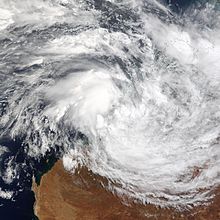- Cyclone Graham
-
Tropical Cyclone Graham Category 1 cyclone (Australian scale) Tropical storm (SSHS) 
Cyclone Graham Formed 27 February 2003 Dissipated 1 March 2003 Highest winds 10-minute sustained:
85 km/h (50 mph)
1-minute sustained:
75 km/h (45 mph)Lowest pressure 985 mbar (hPa; 29.09 inHg) Fatalities 1 Areas affected Australia Part of the 2002-03 Australian region cyclone season Cyclone Graham of the 2002–03 Australian region cyclone season was a weak tropical storm that affected Australia during late February and early March 2003. Graham originated from an area of convection the emerged onto water after sitting over Australia on 23 February. The interaction with a monsoon trough formed an area of low pressure that developed into Tropical Cyclone Graham on 27 February. The storm moved slowly to the east-southeast, and after turning to the south it peaked as a tropical storm and made landfall on Western Australia the next day. The cyclone weakened as it moved inland, and dissipated on 1 March. The storm dropped heavy rainfall and caused high winds, which produced flooding and downed trees. One fatality occurred, though no significant damages were reported.
Contents
Meteorological history
On 23 February 2003, an area of convection that was situated over land for roughly a week emerged over open waters along the northern coast of Australia. The strengthening of a deep, persistent monsoon trough contributed to cyclogenesis, and a low pressure area formed.[1] By 25 February, the low developed a banding feature in which the highest winds were located. Though the storm was located in an area of unfavorable wind shear, the Australian Bureau of Meteorology (BoM) began to issue gale warnings on the system at 0100 UTC the next day, while the low was located several hundred miles north-northeast of Port Hedland. The disturbance was initially nearly stationary as it showed signs of organization due to relaxed shear, and at 0700 UTC on 27 February, the Joint Typhoon Warning Center (JTWC) designated the storm as Tropical Cyclone Graham, as it had attained 80 km/h (50 mph) 10-minute maximum sustained winds. The first warning was issued on Graham later that day.[2]
Initially exhibiting characteristics of a monsoonal low, a mid-level ridge to the south of Graham caused strong westerly winds that moved the storm slowly east-southeastward. However, a deep trough eroded the ridge, allowing the cyclone to move more towards the south.[1] According to the JTWC, the storm had intensified late on 28 February, though at the same time the BoM noted the slight weakening of the storm.[2] Graham reached its peak intensity that day while nearing the coast.[1]
The storm made landfall at Western Australia's Eighty Mile Beach at 1400 UTC on 28 February, and began to weaken. The storm had dissipated on 1 March; the BoM issued their last advisory on the cyclone at 0400 UTC that day, while similarly, the JTWC issued their last advisory just two hours later.[2] The storm's remnants died out in the country's desert.[3]
Impact
In advance of the cyclone, the communities of Wallal, Sandfire, Punmu and Telfer were put on alert. A warning was issued for Bidyadanga, Pardoo and Cotton Creek.[4] The storm's landfall in Western Australia brought heavy rainfall and high winds. The storm dropped 163 mm (6.4 in) of rain at Telfer in one night, over half the town's annual average;[4] total rainfall reached 175 mm (6.9 in) there.[2] The heavy rain caused flooding and road closures, and swelled a river passing through Fitzroy Crossing, though the river only topped its banks slightly.[5] Near that town, at Blue Bush Creek, while a group of people attempted to cross floodwaters, two men were swept away. Both men were rescued, though one died before emergency services arrived.[6] In addition to the flooding, a number of trees were downed.[7] No significant damages were reported.
Following the storm, the name Graham was retired from the Australian region basin.[8]
See also
References
- ^ a b c Bureau of Meteorology Special Services Unit (2003). "Tropical Cyclone Graham (27 February - 1 March)". Government of Australia. http://ssu1.bom.gov.au/wa/cyf/reports/Graham/Graham.htm. Retrieved 2008-09-07.
- ^ a b c d Gary Padgett (2003). "April 2003 Worldwide Tropical Weather Summary". Australian Severe Weather. http://www.australiansevereweather.com.au/cyclones/2003/summ0302.htm. Retrieved 2008-09-07.
- ^ "WA: Cyclone Graham winds down out in the desert". AAP General News. 2003. http://www.highbeam.com/doc/1P1-72158970.html. Retrieved 2008-09-06.
- ^ a b AAP General News (2003). "Cyclone Graham hits WA". The Age. http://www.theage.com.au/articles/2003/03/01/1046407795104.html. Retrieved 2008-09-07.
- ^ AAP General News (2003). "Cyclone Graham winds down". The Age. http://www.theage.com.au/articles/2003/03/01/1046407799918.html. Retrieved 2008-09-07.
- ^ "WA: Man drowns during aftermath of cyclone Graham". AAP General News. 2003. http://www.highbeam.com/doc/1P1-72172523.html. Retrieved 2008-09-07.
- ^ Staff Writer (2003). "WA cyclone warning downgraded". ABC News. http://www.abc.net.au/news/newsitems/200303/s795810.htm. Retrieved 2008-09-07.
- ^ "Tropical Cyclone Operational Plan for South Pacific and Southeast Indian Ocean". World Meteorological Organization Tropical Cyclone Programme. 2006. http://www.wmo.ch/pages/prog/www/tcp/documents/TCP-24OP-PLN2006edition-english.pdf. Retrieved 2008-01-08.
List of retired Australian cyclone names 1960s 1970s 1980s 1990s 2000s 2010s Categories:- Retired Australian region cyclones
- 2002–03 Australian region cyclone season
- Category 1 Australian region cyclones
Wikimedia Foundation. 2010.

